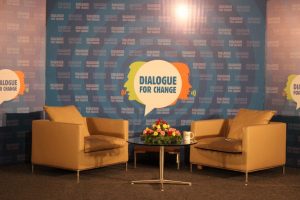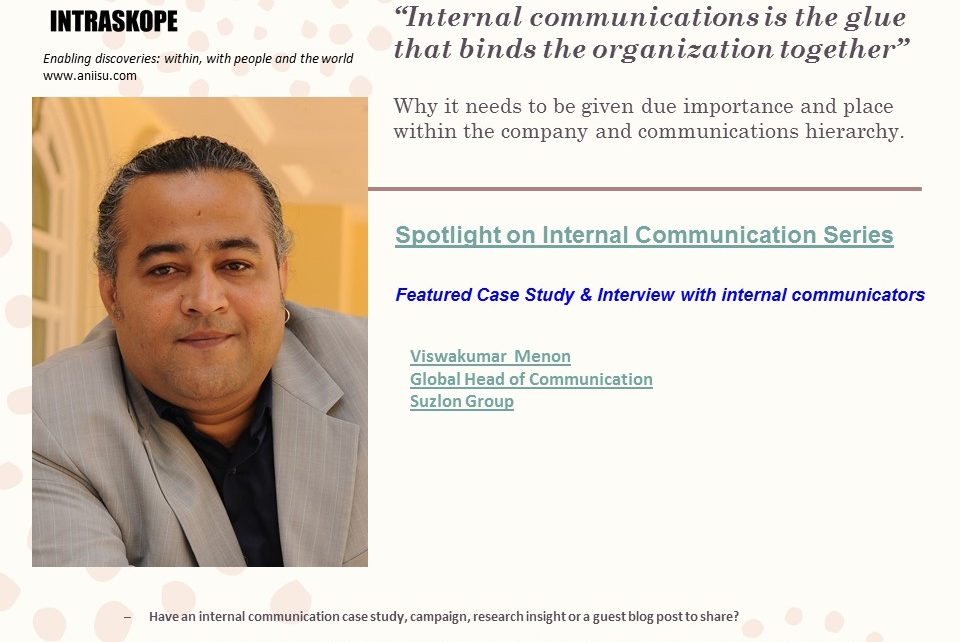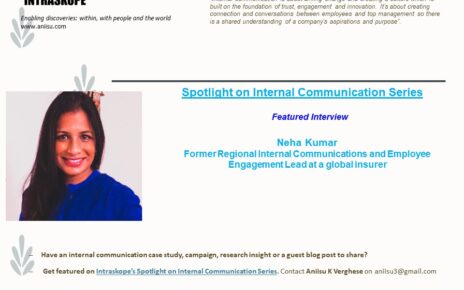How Internal Communications Helped Create an Environment for Dialogue
What can bring different generations of employees together? Can internal communications play a part in building a culture of trust? Read this interesting case study submitted by Viswakumar Menon of Suzlon. The 8th edition of Intraskope’s Spotlight on Internal Communication Series also features an interview with him. Viswakumar believes in empowering employees to openly engage with leaders and influencing leaders to be direct and open in their engagement. Do read the blog and interview below and share your thoughts.
Views expressed in this case study and interview are Viswakumar’s and do not reflect those of the organization he worked or works for.
Viswakumar Menon – Global Head of Communication – Suzlon Group
The company faced an interesting challenge. It had two distinct sets of employees – some battle-hardened veterans who had served over ten years and on the other hand, people who were less than a year old in the company. The company itself was resurfacing after a severe crises driven by the financial meltdown.
The veterans were well-versed and accustomed to the fickle nature of the industry and nothing fazed them. That also meant that they took all new initiatives and different approaches to business not so enthusiastically. The newcomers were more forthcoming and adaptive of newer changes. But they found it difficult to progress and were often rattled as the industry conditions grew tougher. It soon became a challenge to retain new talent that the company invested in.
While the machinery within company, i.e., HR, policies and leadership got engaged to improve understanding of diversity issues, the internal communications team thought of introducing a radical idea. We observed a big disconnect between what senior management believed and how employees perceived all the different communications they received. Internal emails and company newsletters spun out a lot of information, but the employees took it with a pinch of salt. Due to the external conversations they heard about the sector, which sounded a lot different and grimmer, they were confused.
We identified an engagement model that blended a bit of the old (fireside chats), Town hall and new (Coffee with Karan format), which the team developed into a platform – Dialogue for Change. Note: Coffee with Karan is a long running talk show in India featuring movie personalities and anchored by a leading film maker.

Our premise included creating:
- A culture of sharing business ideas, vision, knowledge and experience
- Trust building measures
- An approach to inspire employees to achieve goals
- A platform for providing employee opportunities
- A knowledge sharing platform for emerging leaders
Revolving around a chat show for about one hour, this show had a leader speaking about a current topic (for i.e., CFO during results, Chairman at the start of the year, etc.) with a diverse audience that is present in-person. The audience chosen had the least likelihood of interacting with the leader on a regular basis. The leader posed questions on a range of topics both professional and personal – ranging from what motivates him to get up and come to work to what are his professional challenges and what does he do to bring about work-life balance.
We kept the mood deliberately easy and non-controversial. With the event directed for employees only, leaders let their guard down and had heart-felt conversations. They answered questions from the audience and then at the end, also spent time to interact with them off-record. We beamed the program live to all offices and within a day or two, the program got hosted on the intranet for those who missed the live telecast.
The magic unfolded when the employees, now overcoming their reticence, reached out to the leader with pertinent questions about daily life at work and on how they addressed work-life issues. For instance, it was during a casual conversation that the employees realised that a leader stayed away from his family and met them only during weekends. It was the family’s joint career decision and had been that way for quite a few years and they seemed quite comfortable with the arrangement. A lot of youngsters had so many questions of how that worked and maybe questioned their individual positions if work took them away from their families.
Within a year and six episodes later, we witnessed a set of changes. Employees got an understanding of what took place within the organization even in areas beyond their own role. The opportunity to watch leaders interact and address personal and professional issues, just like any of them, resonated strongly. It became a coveted spot for the leaders to connect within the company as well as the employees who waited eagerly bi-monthly to watch another part of the organization being brought to life. Yet another way in which internal communication can think out-of-the-box to address employee issues impacting performance and tenure.
The show now extends beyond leaders and showcases professionals in key roles within the organization. The operational insights are also much sought after and it is not surprising to find the Group CEO or CFO walk in to join the audience and be a part of the conversation. Conversations are after all what makes a family.
Interview
- What does internal communication mean to you?
Internal communications is the glue that binds the organization together. It ensures there is shared understanding of the company’s values and culture. It informs, motivates and shortens the distance between the people, offices, geographies and differences within the organization.
- How is it practiced in your organization?
Openly and in a frank manner. There is a lot of candid conversations that takes place and the function is allowed to operate in a professional manner despite the perceptions of it being a family run Indian company. While it is inspired by the broad direction and guidelines of the management, it is given its due importance and place within the company and communications hierarchy.
- Please share an example/campaign that you are personally proud of working on and that made a significant impact to your organization. Kindly elaborate.
- Dialogue for Change – Creating a new platform which bridges the distance of the leadership team and rest of the employees across the organization. This has been rated as one of the best platforms with over 90% approval rating among employees.
- Ideas4More – This was a platform created for sharing ideas across the organization to bring efficiency and effectiveness within. The entire process was created were prominent yellow branded boxes was placed at key stations within all offices, factories and sites. Leaflets (translated where English was not spoken much) placed allowed any employee to enter improvement ideas to get discussed. The ideas were routed to the respective department head for their review. This initiative had over 400 individual ideas of which over 25% were considered for implementation. We now are looking at taking it up for the next stage by going online shortly to make the process more accessible.
- What is the biggest challenge you face while going about managing internal communication?
- Too many stories and too less time. So many great stories are happening every day and it is a challenge to capture them real-time, curate and convert into a palatable format in text or film. When we started, it took a while for employees to open up and share their stories. But once they understood where we were coming from and what we were producing on the basis of their inputs, we now have more inputs than what we are able to churn out.
- What according to you is the biggest opportunity that internal communicators have?
- Technology and the ways of how it can be harnessed to build platforms and narratives within the organization. It is literally exploding and the only limitation is our own imagination.
- How can internal communicators add more value to the business?
- To stay close to the business and be the positive narrative of the organization. As long as that objective is the true north of the function, there is very little that can go wrong. Don’t wait for someone else to define the role and ask for initiative we should be doing proactively anyway. The minute we are behind, the situation can turn tricky soon. Internal communication is a combination of public relations, digital and marketing communications rolled into one. The best part is our audience is also very well defined, so it has so much scope to bring people together.
- What is your advice for people who are keen to join internal communication and make a career? What skills must they have or develop?
- Internal communication is a bit more intense as it combines all the other functions (content, PR, digital, marketing communication, events) as well as understanding the rest of the organization’s idiosyncrasies. Most times, it is also the first function to bear the brunt if any employees complains about the lack of communication within the organization. The reasons could be anything but the heads turn towards the person handling internal communication. Hence, it is a job which absorbs a lot of pressure and deliver against unrealistic timelines. If finding common ground between 100, 10000 or 5000000 employees and build engagement is your thing, you are a rare commodity and should continue developing those skills as they are hard to come by and even more difficult to retain as sometimes, it does become thankless. Self-motivation should be your other best friend.

